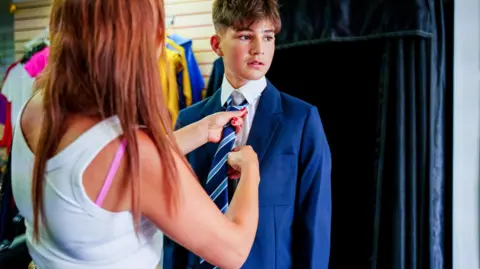In England, low-income families are facing significant challenges due to the rising costs associated with school uniforms. Recently, one of the UK’s largest debt advisors, Money Wellness, has advocated for the introduction of standard grants to assist these families. This call for assistance comes amid troubling statistics that reveal a stark divide in the available support for uniform costs across the UK. While families in Scotland, Wales, and Northern Ireland can access financial aid between £93 and £200 for school clothing, the situation in England presents a significantly different landscape.
In practice, only a small fraction—22 out of 153 local education authorities in England—provide dedicated support for school uniform costs. Further complicating matters, an additional seven councils only extend help in exceptional circumstances, such as instances of homelessness or natural disasters like fire and flooding. This has led to a “postcode lottery” where the level of support families can expect is heavily dependent on their local authority. The disparities are evident, with some councils in London or Yorkshire offering grants between £30 to £170, while the majority of councils provide no assistance at all.
Moreover, the financial implications of securing school uniforms can be staggering. According to figures from the Department for Education (DfE), the average expenditure for a primary school uniform is around £340, and about £454 for secondary school students. Despite recent changes in legislation aimed at limiting the number of branded items schools can mandate, which is expected to save families over £50, many still find the overall cost unaffordable without additional support. Adam Rolfe, the policy and public affairs officer at Money Wellness, emphasizes the urgent need for a consistent approach to address this issue, highlighting that many families remain disadvantaged based on their geographical location.
As the summer vacation comes to a close, the urgency surrounding uniform purchases surges. Organizations like the Children’s Society have noted a significant increase in traffic at school uniform banks, places where families can obtain second-hand goods. For parents like Carrie, who recently sought uniforms for her son Dillon as he transitions to secondary school, these banks have proven invaluable. Carrie expressed the financial pressures faced, noting that uniform expenses extend beyond clothing to shoes and sports gear—an ongoing challenge exacerbated by the rapid growth of children.
This is not an isolated problem affecting only lower-income households. Families from various financial backgrounds are grappling with the escalating costs tied to schooling. Jason, another parent, voiced concerns about how rising household bills, such as utilities and council taxes, intensify the financial burden at the start of the school year. He described the universal struggle for families to balance their finances amid increasing living costs.
Additionally, recent trends indicate a shift in attitudes toward second-hand clothing. Many parents, such as Josh, have moved away from the stigma once associated with used uniforms, recognizing the practicality and savings involved. As attitudes evolve, the sustainability aspect of second-hand shopping is also gaining traction, as families are encouraged to reduce waste and avoid clothing landfills.
Efforts from community organizations, such as the Green Uniform and Baby Bank in Cheshire, reveal the growing demand for support in this area. Michelle Hawthorne, who runs such an initiative, noted the immense pressure these costs place on families, particularly those with multiple children. The Department for Education acknowledges these concerns and is working on measures to alleviate financial strain, including controlling school uniform costs tied to branding.
As families gear up for the upcoming school year, the pressing need to tackle the affordability of school uniforms remains a priority. Several options for families to save money on uniforms include inquiring about local council grants, checking with schools on second-hand sales, or consulting charities like Turn2Us for assistance. With schools returning in just a few weeks, the time for action is now to ensure all children have access to the uniforms they require without financial hardship.












